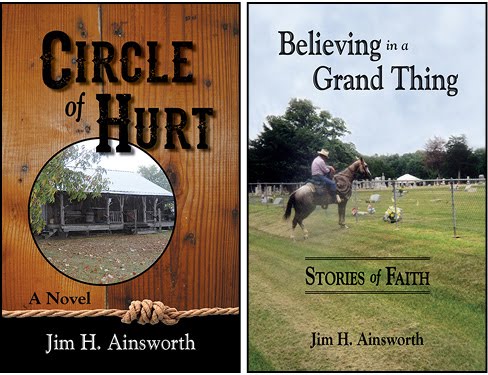We arrived a half-hour early for the memorial service, so I
drove past the church, through what is left of downtown Enloe, Texas, calling
up memories from long ago and pointing out to wife Jan landmarks of my
childhood and homes of people and businesses long gone. I’m not from Enloe, but
I am from tiny Delta County, and that’s close to the same thing.
The Enloe State bank is shuttered now, moved to nearby
Cooper, the county seat of Delta County (population about 2500). From the looks
of things, Enloe would probably have to count dogs and cats to reach 200. The
bank was robbed at least twice in the last half century as thieves saw its
out-of-the-way location and lack of a police force as easy pickings. Besides
the bank, Enloe had an operating cotton gin, a thriving seed processing plant,
a restaurant, and a general store when my father borrowed his money there.
I got my first car loan at that shuttered bank. Carl Adams,
(I think he was bank president), gave me a shirt-pocket-sized payment book. I
mailed the book back to him with each payment. Carl would figure the interest
and new balance, enter it in the book, and mail it back. I still have it,
marked paid in full. A rush of memories almost brought tears to my eyes when we
passed the closed bank again on our way back to the church. Daddy borrowed
money there for crops, cattle, equipment, and sometimes . . . groceries. I
recalled this scene from my first novel:
From Main Street in
Enloe, Gray Boy and Jake looked through the front window of the Enloe State
Bank at their father. Rance sat in a chair in the bank lobby close to the
marble teller cages. He was restless, shifting his weight and drumming his
fingers on the arms of the chair. Jake thought he looked worried, vulnerable, maybe
even a little frightened. The check from the sale of the dairy cattle peeked
from a bib pocket in his overalls.
I wonder if the way of life I knew as a child has vanished
forever. I grew up near Klondike, and I don’t think that a single business from
my childhood has survived there. I know that my children and grandchildren will
never experience the type of hardscrabble but rewarding life I had growing up
in an area that represents real country life—not just rural. I am a full-blood East
Texas Country Boy and there are fewer and fewer following that trail.
When we parked and walked toward the Enloe Methodist Church
for the memorial service, I took a closer look at the church I had never really
observed before. It was old, but maintained well and possessed of great
character and charm, built in 1919 after the previous one burned on Easter
Sunday. My father’s family arrived in Delta County by covered wagon in 1918.
We were there for the service on the day before Easter
Sunday.
When I saw a friend and schoolmate from my distant past entering
the church, an unexplained wave of nostalgia brought an effect I can’t properly
describe—a feeling of loss combined with a sense of pride in what we once had. Since
it was close to the anniversary of the church’s burning, I wondered if the old
church was putting forth some type of aura. But it was probably because the
church resembles the ones in Klondike I am familiar with.
The inside was every bit as appealing as the outside,
especially when it began to fill with familiar faces—some recent and current
friends, but many from long, long ago. Memories almost overwhelmed me as I saw
eyes, faces, and expressions that looked familiar, but drastically changed. I
searched my memory for names and events associated with various people as they
filled the pews. Others searched their memories as they looked at me. Faces
were lined like mine, many backs bent, but they all still seemed full of Delta
County grit, faces that had weathered adversity and still showed courage. And
they were from all four corners of this tiny county.
Judy came over to give me a hug. She and I started first
grade at West Delta together. As we walked in the school at the same time on
that first day, Mother insisted that I give her one of my precious new pencils Daddy
had bought from the charred inventory of the Trotman and Ward store that burned
in Klondike. I didn’t feel the loss so bad when I discovered the fire had made the erasers on the
pencils useless.
Then Freddie Mike, Judy’s brother, shook my hand and I was
reminded of this scene from Rivers Flow:
The Indians loaded the
bases in that first inning. When Jake advanced to third, Coach Simpson and Linc
Little discussed strategy before Linc stepped into the batter's box. Linc
slammed the first pitch twenty feet beyond the left field fence for a
grand-slam home run.
Freddie was the inspiration for Linc. Freddie and Judy are originally
from Klondike, and Judy married Ted, an Enloe boy, the brother of Bob, the man
we came to honor. Lanny, her oldest brother and also a great athlete, sat in
the pew just in front of us. Those kinds of connections filled the small
church. Bob’s family has deep roots in the community and I saw many other
families represented who had been in the area for generations.
It’s hard to describe the actual memorial service. There was
reverence without formality. I saw no ushers, no funeral director. As the pews
filled, church members appeared with additional chairs. Flowers appeared and
were carried to the front. A man played the piano without looking at sheet
music or the keys, often carrying on conversations with the people seated
behind him. He signaled a surprised member of the audience to come up and lead
the singing. We sang two verses of Amazing
Grace and I’ll Fly Away without
hymnals.
When the minister stepped to the pulpit to present the
obituary, he made a lighthearted joke about taking up a collection while he had
a full church. I looked at the bulletin board that said attendance on Sunday last
year was 23 and this year 24. Bob’s nephew, a minister and Judy’s son,
delivered a warm and humorous eulogy for his uncle. Bob had been an outstanding
athlete, family man, a gregarious friend to many, and a citizen who returned to
his roots in his final years.
Outside after the service, I got a hug from a relative of
Bob’s who had been my client many years ago. She and her husband were special,
memorable people. They had invited Jan and me to their farm to pick roast’n’ ears
almost thirty years ago. There were too many connections to recall here, too
many faces that I connected to memories and not names and vice-versa.
After the service, an acquaintance from another state,
impressed and surprised by the uniqueness, the genuineness, and the warmth of
the service told me that gatherings like this reminded him why East Texas was
his favorite part of the state. I
started to explain the history of the old days of competition between Enloe,
West Delta (Klondike), East Delta (Charleston), and Pecan Gap, schools long ago
consolidated into Cooper. But well, you just had to be there back then to
understand those jam-packed gyms and the friendly but intense rivalry between
the four schools of Delta County.
As we drove away, I told Jan I would never forget the
service. Maybe it was the way that folks just knew that church members would
step up to the plate with food, chairs, music, and whatever else was needed in
spite of the absence of a funeral director. Maybe it was that feeling of
celebration of life rather than sorrow at death that many services talk about,
but few achieve. Maybe it was because I lamented about a way of life that is
vanishing while rejoicing because Bob’s services proved that some of it still
remains.


